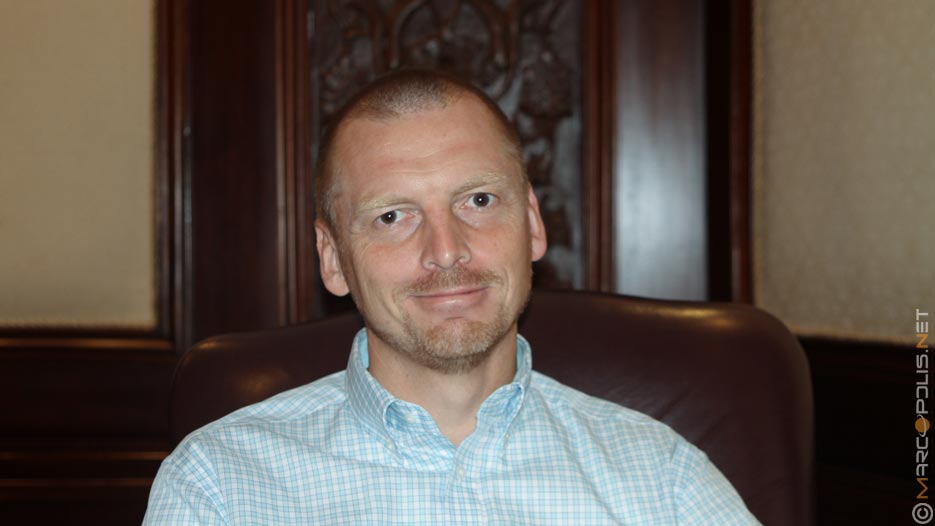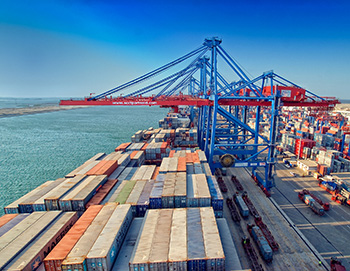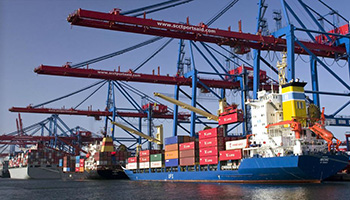The Suez Canal Container Terminal (SCCT): The leading container terminal on the Suez Canal
“The SCCT is a true success story for Egypt… There is no other container terminal on the Suez Canal on the Mediterranean end able to handle very large container vessels. Therefore, our main competitive advantage is our prime location. There are facilities close by on the Mediterranean but we stand out because of our size,” explains Klaus Holm Laursen, CEO of Suez Canal Container Terminal (SCCT).
Interview with Klaus Holm Laursen, CEO of Suez Canal Container Terminal (SCCT)

What is your assessment of the logistics and shipping sector in Egypt at the moment? What are the latest developments going on in this particular sector?
Egypt is very strategically located on the main trading routes from the Far East to North Europe via the Suez Canal. Therefore, Egypt truly plays an important role in global trade and moving goods between these regions. This is where the Suez Canal Container Terminal (SCCT) comes into play, because we are located right on the Suez Canal. With this location, we can help the whole shipping community transport their containers and boxes around the entire East Mediterranean area and at the same time, we are helping Egypt itself. Egypt has prepared itself very well for thousands of years with the Suez Canal but also recently, we have seen a lot of activity in the corridor around the Canal. There are many opportunities for logistic business in Egypt going into global trade. For the local market, it is also interesting as it is a 90 million people society and so when we get stability back and we have economic growth it is going to be very interesting to be in transport.

Please tell us the story of how you became one of the largest transhipment hubs on the Mediterranean.
The SCCT is a true success story for Egypt. Back in the late 90s, Egypt developed a vision for creating an east port in Port Said, which is at the access point of the Suez Canal to the Mediterranean. Via public tender, they attracted investors including the AP Moller Terminals to invest in a container terminal. We started constructing the terminal around the year 2000 and became operational in 2004. This year we celebrate our 10th anniversary.
The SCCT is a container terminal with a very strategic location. It is also a facility with a lot of ability to do this kind of business; we have a fantastic local workforce that has the ability to move boxes quickly and safely, which is really what this business is all about. Thus, we have a great location, a great workforce and the right equipment.
In 2004, we had 1,200m of quay and in 2009 we started further construction to double the capacity of our facility. Last year we achieved this and so we now have 2.4km of straight quay wall. I´m happy to say that our customers like to use our facility.
You mentioned the workforce and location, what other elements distinguish you from your competition on the Suez Canal?
There is no other container terminal on the Suez Canal on the Mediterranean end able to handle very large container vessels. Therefore, our main competitive advantage is our prime location. There are facilities close by on the Mediterranean but we stand out because of our size. Our quay, yard, cranes and water depth are all of a size that can handle the biggest container vessels in the world, which is very important. If you look at the container industry over the last eight to ten years, the vessels have become bigger and bigger. If you compare the current situation with what was the reality in 2000, the biggest vessels were around 7,000 TEU back then however today, they are about 18,000 TEU, i.e. more than double the size. That´s why size is a huge advantage for us.
The SCCT registered 9% growth last year in 2013. What are your forecasts for this year and for 2015?
Our main competitive advantage is our prime location. There are facilities close by on the Mediterranean but we stand out because of our size
We think that this year we will have about 7 to 10% growth. Towards the end of the year, we are going to get more equipment, for example, we are going to get some bigger cranes, and so we believe that we will see very healthy growth in 2015. Whether that will be 8, 9 or 10% growth, I don’t know for sure, but we expect really good business growth over the coming two or three years.
You are currently running training programs for the Egyptian youth; can you tell us a bit more about this and other CSR activities that you are involved in?
Last year, Egypt was challenged economically and we felt that we had to play our part in helping the country. One way we thought we could do this was by helping young people get an entry into their work life. Often a person´s first job is extremely important because generally it can be very difficult to find. Together with the Arab Academy, we created 155 positions last year for apprenticeships where we offer to take people from the Arab Academy and offer them a one-year apprenticeship where they come to work at the facility where we give them skill based training for operating our equipment. We pay them a salary, so not only do they get a job with real money in their pockets to take back home to their families and friends but also with the training, we also create job opportunities for them to get a job either with SCCT or in another part of the industry. We give them a salary, training and work habits, which are all very important when you are looking for future career opportunities.
We do all kinds of other initiatives. We are primarily focused in our local community in the Port Said area. Last year, we started holding a youth day for very unfortunate children who have lost their parents and are living in shelters. The project is driven by our workforce who take the kids out for a nice day with adventure and fun. Last year we donated a bus to one orphanage because unfortunately their bus was destroyed during the riots in early 2013. We thought it was very important that these children have a way of getting to school so we bought them a bus. Hence, we do various things in the local area, mainly for kids and young people and health programs.
 Are you planning on further expansion apart from the phase II plans?
Are you planning on further expansion apart from the phase II plans?
Expansion comes in our business in two phases; first you expand your footprint, which is concrete expansion because once it´s there it´s there. Right now, we do not have plans for further increasing our footprint. We have opportunities to do so, and I think that in a year or two from now we may start looking at these opportunities. Right now, we are focusing on the 2.4km of quay wall that we already have. Presently we have 18 quay cranes, and we will receive another two quay cranes towards the end of the year. Provided we get some of the supporting infrastructure around the port in place, we will certainly also be looking at further investment. When you work in infrastructure, you become very dependent on the surroundings, on the authorities and on the businesses in this sector. Right now, we lack a little bit of access to the east port and so we are waiting for the Egyptian government to enlarge the navigational access, i.e. the number of vessels that can come in and out of East Port Said. Once that it is in place, it makes sense to start looking at further increasing our capacity. It is much like a supermarket: if you do not have a big enough door, people cannot get in and out of it and there is no reason to have more aisles!
What other challenges do you face on a daily basis?
Egypt is an interesting country but it has had a very difficult time what with the revolution in early 2011. Ever since then, there has been a lack of stability in society and a lack of ability in society to make decisions and move forward. This has really been driven by the political situation. Last year we even started seeing even more security issues.
However, I have to say that since last fall we have since good progress. Security has been stepped up. If you drive up to the Suez Canal you will see how much more security is available. You will also find much more security on the streets. The authorities have started to have confidence in themselves once more. Previously everybody was afraid that they would be taken to court by someone and therefore no decisions were made and everything stopped. These things are now getting back on track and I think that after the parliamentary elections Egypt will start moving again after three years of doing nothing. This will help the economy and it will help our business.
What is your personal vision for Egypt over the next few years?
In international terms, I would like to see Egypt fulfil its role in international trade, particularly in terms of the Suez Canal. The canal is truly amazing. Imagine being in the 1850s standing by the Mediterranean, looking at sand and saying ´I think I will dig a canal 179km through the desert for ships to go through´ and then achieving that! It is such an amazing feat. Go out and see the big vessels going through. You can almost touch them!
There are so many opportunities for logistics and trade in Egypt. Therefore, my first vision would be for the Suez Canal and the government of Egypt to succeed in developing more business in relation to the Suez Canal.
Secondly, I would like to see further development of the economy in general; to get back into what we all know Egypt for i.e. the tourism attractions, the pyramids, the diving at Sharm el Sheikh etc.
Thirdly, there are 90 million people in Egypt and Egyptians are good workers; they like to work. Hence, there are many opportunities for developing the production industry in Egypt that will create prosperity for a country that today, is relatively poor. There are many opportunities out there.
FAIR USE POLICY
This material (including media content) may not be published, broadcasted, rewritten, or redistributed. However, linking directly to the page (including the source, i.e. Marcopolis.net) is permitted and encouraged.